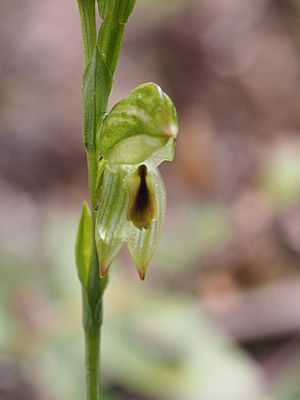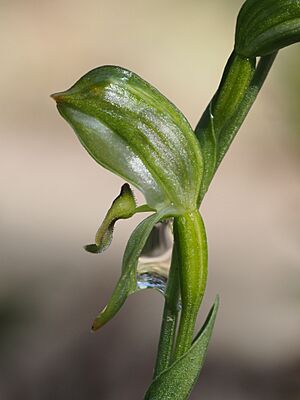Barrington leafy greenhood facts for kids
Quick facts for kids Barrington leafy greenhood |
|
|---|---|
 |
|
| Pterostylis barringtonensis in the Barrington Tops State Forest | |
| Scientific classification | |
| Genus: |
Pterostylis
|
| Species: |
barringtonensis
|
| Synonyms | |
|
Bunochilus barringtonensis D.L.Jones |
|
The Barrington leafy greenhood (Pterostylis barringtonensis) is a special kind of plant. It belongs to the orchid family, which is known for its beautiful flowers. This plant is found only in New South Wales, Australia. We call this "endemic" because it grows naturally in just one place.
This greenhood orchid looks different depending on if it's flowering or not. Plants that are not flowering have a group of leaves shaped like a circle, called a rosette. These leaves grow on a short stem. But when the plant is ready to flower, it grows a taller stem. This stem can have up to seven dark green flowers and some leaves along it. The Barrington leafy greenhood is only found in the Barrington Tops area.
What Does It Look Like?
The Barrington leafy greenhood is a plant that grows from an underground tuber. A tuber is like a small, round storage part, similar to a potato. This plant is a perennial herb, meaning it lives for more than two years and has soft, green stems instead of woody ones. It is also deciduous, which means its leaves fall off at certain times of the year.
Plants that are not flowering have a group of leaves called a rosette. There are usually three to six leaves in this rosette. Each leaf is about 1.5 to 5 centimeters (0.6 to 2 inches) long and 0.4 to 0.8 centimeters (0.16 to 0.3 inches) wide. These leaves grow on a short stalk, which is about 3 to 6 centimeters (1.2 to 2.4 inches) tall.
When the plant flowers, it does not have a rosette of leaves at its base. Instead, it grows a tall flowering stem, about 20 to 30 centimeters (8 to 12 inches) high. This stem has five to seven long, thin leaves along its length. These stem leaves are about 3 to 6.5 centimeters (1.2 to 2.6 inches) long.
The flowers themselves are dark green. They are about 1.4 to 1.8 centimeters (0.55 to 0.7 inches) long and 0.4 to 0.6 centimeters (0.16 to 0.24 inches) wide. The top part of the flower, called the "galea," looks like a hood. It is made from the sepals and petals joined together. This hood covers the central part of the flower. The galea is dark green with darker lines and has a brown, pointed tip.
The side parts of the flower, called the lateral sepals, point downwards. They are about 1.1 to 1.3 centimeters (0.43 to 0.51 inches) long. These sepals are joined together for about half their length. The "labellum" is a special part of the flower that looks like a tongue. It is about 0.6 to 0.7 centimeters (0.24 to 0.28 inches) long and brown, with a dark stripe down its middle. This orchid usually flowers between June and August.
How It Got Its Name
The Barrington greenhood was first officially described in 2006. A botanist named David Jones gave it the scientific name Bunochilus barringtonensis. He published this description in a scientific book called Australian Orchid Research. The plant he studied was found in the Barrington Tops National Park.
Later, in 2010, another botanist named Gary Backhouse changed its name to Pterostylis barringtonensis. The second part of its name, barringtonensis, tells us where this plant grows. The Latin suffix -ensis means "place for" or "where." So, barringtonensis means "from Barrington Tops."
Where It Lives
The Pterostylis barringtonensis plant grows in wet areas within tall forests. It is found only in the Barrington Tops region of New South Wales.


